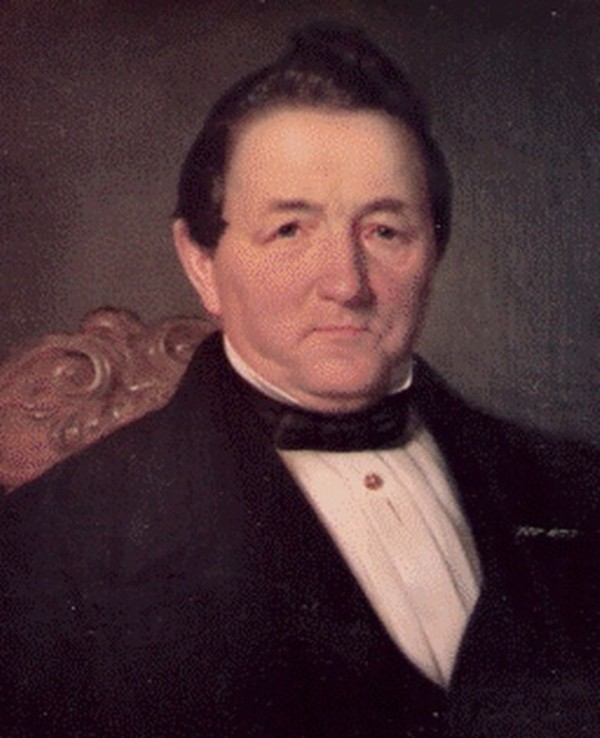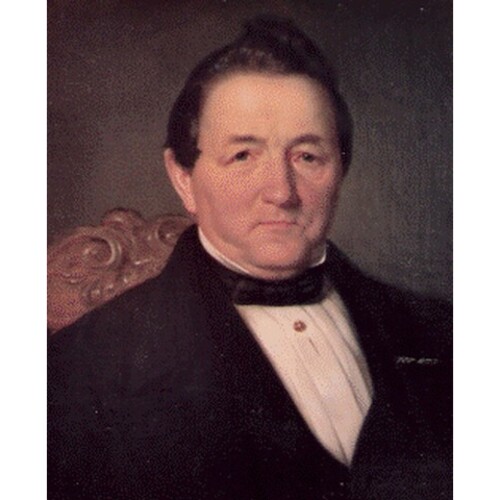
Source: Courtesy of Wikimedia Commons
BOYER, LOUIS (he sometimes signed Boyer, dit Quintal), mason, merchant, and land owner; b. 30 Nov. 1795 at Montreal, son of François Boyer and Josette Boutonne; d. 21 Dec. 1870 in the same town.
Louis Boyer’s career is an interesting illustration of upward social mobility. He was called a mason at the time of his first marriage, on 2 Oct. 1820, to Elisabeth Mathieu, dit Laramée, and his father-in-law, Joseph, of Montreal, was called a carter. The witnesses, described only as uncles of the couple, informed the parish priest that they, “like the husband and wife, could not sign their names.” At his second marriage, on 14 July 1836, at Saint-Joseph-de-Chambly, Boyer described himself as the “Sieur Louis Boyer, merchant.” His wife, Marie-Aurélie Mignault, was the daughter of the postmaster of Saint-Denis-sur-Richelieu and the niece of the parish priest of Chambly, Pierre-Marie Mignault. The bridegroom’s nephew Louis Boyer, a certain John Elliott, esquire, two priests, James Moore, and Charles La Rocque* attended the ceremony. Unlike the first marriage, all the participants signed the register. On 24 Dec. 1870, at Boyer’s burial, there was an impressive number of witnesses, including the mayor of the town William Workman*, Judge Joseph-Amable Berthelot, Senator Jacques-Olivier Bureau, and Romuald Trudeau*. Two Montreal papers, La Minerve and the Gazette, carried an obituary. It seems that the death of his first wife, on 24 March 1836, marked a decisive break in Boyer’s life, rather as if it allowed him a fresh start. He had been absent from his wife’s funeral, his will, drawn up on 23 Aug. 1832, had made no provision for her, and he remarried with speed. Was there a desire to forget the past, or to efface it?
The early part of Louis Boyer’s career is somewhat obscure. According to John Douglas Borthwick, he was one of the masons who built the Rideau canal and the Kingston prison. The first contracts for the Rideau canal were assigned in the spring of 1827, and never lasted more than three years. In any case, in 1829 Boyer was living at Montreal, and gave his profession as purveyor of bacon.
It was in foodstuffs that Louis Boyer was to build the fortune that would be systematically invested in landed property. Gradually, as successive notarial contracts were drawn up, the designation “purveyor of bacon” gave place to that of merchant, even businessman. In the Montreal directory of 1842–43, he was “Provision merchant,” and in 1852–53 “Provision and fur merchant.” Towards the end of his life, the directory styled him “Provision and produce merchant.” He dealt in pork, beef, cut meats, butter, and cheese. This part of the provision trade would undergo a phenomenal expansion in the second half of the 19th century.
Louis Boyer worked on his own for a short time, then on 13 April 1832 went into partnership with Joseph Vallée, Fleury-Théodore Serre, dit Saint-Jean, and Philippe Turcot Sr, “all purveyors of bacon, furs, and other commodities.” The company was capitalized at £6,500, of which Boyer contributed £2,000. It was called Vallée, Boyer et Compagnie at Montreal, and Vallée, Saint-Jean et Compagnie at Quebec (the company had a branch at Quebec from its beginning). The firm lasted at least ten years; setup originally for three, it was extended for another three years on 18 July 1835 by an endorsement to the original contract, and Vallée et Boyer still appears in the directory of 1842–43, under the heading “Provision merchants.” During the next decade Louis Boyer apparently carried on on his own. In 1856–57, however, another company, Boyer and Hawley Provision and Fur Merchants, appears at the same address. Towards the end of his life he went into partnership with his sons as Louis Boyer et fils. In 1868 he gave up all commercial activity, leaving his premises to his two eldest sons and investing $80,000 in their company (Boyer, Hudon et Compagnie). They traded in foodstuffs, spirits, and other commodities.
Louis Boyer’s interest in landed property began early in his career. In 1819, when he was a mason, he had exchanged a site in the faubourg Saint-Laurent, which he had received from his sister. After 1829 especially his activity in this sphere expanded, paralleling his career as a merchant to such an extent that Boyer’s biographer portrayed him first of all as a landed proprietor. A series of real estate transactions made him by the end of his life one of the biggest property owners in Montreal. Boyer’s example confirms the theory that landed property constituted the preferred basis of economic activity for the French bourgeoisie. In addition to properties outside the town, around 1870 Louis Boyer possessed 21 urban lots which totalled more than 1,000,000 square feet. The name of faubourg Boyer was even given to one of his large landholdings.
Banking also interested Louis Boyer. He was listed as an honorary director of the Montreal City and District Savings Bank from its inception in 1846, and in 1870 he owned 104 shares in the Banque Jacques Cartier, of which he was a director. On 12 Dec. 1847 he was elected churchwarden of the parish of Notre-Dame in Montreal, and he was a member of the Montreal Board of Trade. At the time of his death his estate was valued at more than a million dollars. Five children, including the politician and merchant Louis-Alphonse, were born of his second marriage.
AJM, Registre des sépultures, cimetière de Notre-Dame-des-Neiges, 21 déc. 1870. ANQ-M, État civil, Catholiques, Notre-Dame (Montréal), 30 déc. 1795, 2 oct. 1820; Saint-Joseph-de-Chambly, 28 mars 1836; Greffe de Joseph Belle, 11 juill. 1854; Greffe de J.-O. Bureau, 7 janv., 17 oct. 1871; Greffe de J.-M. Cadieux, 9 déc. 1819; Greffe de Peter Lukin, fils, 2 mars 1819, 13 avril, 23 août 1832. Can., Doc. de la session, 1870, III, no.6. W. J. Patterson, Report of the trade and commerce of the city of Montreal, for 1863 . . . (Montreal, 1864). L.-W. Sicotte, Extraits des livres de renvoi des subdivisions de la cité de Montreal (Montréal, 1874). Gazette (Montreal), 23 Dec. 1870. La Minerve, 22 déc. 1870. Borthwick, History and biographical gazetteer, 442; Montreal, 47. H. W. Hopkins, Atlas of the city and island of Montreal, including the counties of Jacques Cartier and Hochelaga . . . (n.p., 1879). Montreal directory, 1842–68. J. P. Heisler, The canals of Canada (Canada Historic Sites: Occasional Papers in Archaeology and History, 8, Ottawa, 1973), 81–86. T. T. Smyth, The first hundred years; history of the Montreal City and District Savings Bank, 1846–1946 (n.p., n.d.), 15, 165. H. P. Hill, “The construction of the Rideau Canal, 1826–1832,” OH, XXII (1925), 117–24. P.-A. Linteau et J.-C. Robert, “Propriété foncière et société à Montréal: une hypothèse,” RHAF, XXVIII (1974–75), 45–65.
Cite This Article
Jean-Claude Robert, “BOYER (Boyer, dit Quintal), LOUIS,” in Dictionary of Canadian Biography, vol. 9, University of Toronto/Université Laval, 2003–, accessed April 9, 2025, https://www.biographi.ca/en/bio/boyer_louis_9E.html.
The citation above shows the format for footnotes and endnotes according to the Chicago manual of style (16th edition). Information to be used in other citation formats:
| Permalink: | https://www.biographi.ca/en/bio/boyer_louis_9E.html |
| Author of Article: | Jean-Claude Robert |
| Title of Article: | BOYER (Boyer, dit Quintal), LOUIS |
| Publication Name: | Dictionary of Canadian Biography, vol. 9 |
| Publisher: | University of Toronto/Université Laval |
| Year of revision: | 1976 |
| Access Date: | April 9, 2025 |



